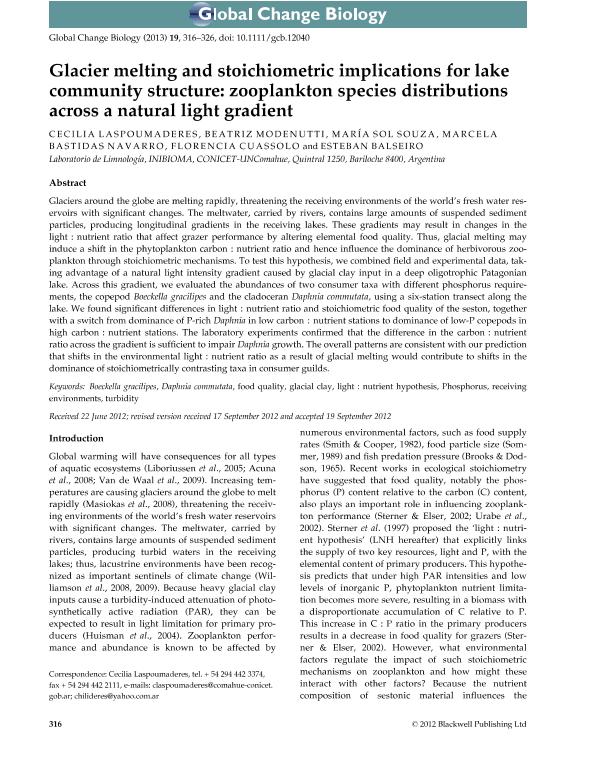Mostrar el registro sencillo del ítem
dc.contributor.author
Laspoumaderes, Cecilia

dc.contributor.author
Modenutti, Beatriz Estela

dc.contributor.author
Souza, María Sol

dc.contributor.author
Bastidas Navarro, Marcela Alejandra

dc.contributor.author
Cuassolo, Florencia

dc.contributor.author
Balseiro, Esteban Gabriel

dc.date.available
2016-07-26T19:26:44Z
dc.date.issued
2013-02
dc.identifier.citation
Laspoumaderes, Cecilia; Modenutti, Beatriz Estela; Souza, María Sol; Bastidas Navarro, Marcela Alejandra; Cuassolo, Florencia; et al.; Glacier melting and stoichiometric implications for lake community structure: zooplankton species distributions across a natural light gradient; Wiley; Global Change Biology; 19; 1; 2-2013; 316-326
dc.identifier.issn
1354-1013
dc.identifier.uri
http://hdl.handle.net/11336/6691
dc.description.abstract
Glaciers around the globe are melting rapidly, threatening the receiving environments of the world´s fresh water reservoirs with significant changes. The meltwater, carried by rivers, contains large amounts of suspended sediment particles, producing longitudinal gradients in the receiving lakes. These gradients may result in changes in the light : nutrient ratio that affect grazer performance by altering elemental food quality. Thus, glacial melting may induce a shift in the phytoplankton carbon : nutrient ratio and hence influence the dominance of herbivorous zooplankton through stoichiometric mechanisms. To test this hypothesis, we combined field and experimental data, taking advantage of a natural light intensity gradient caused by glacial clay input in a deep oligotrophic Patagonian lake. Across this gradient, we evaluated the abundances of two consumer taxa with different phosphorus requirements, the copepod Boeckella gracilipes and the cladoceran Daphnia commutata, using a six-station transect along the lake. We found significant differences in light : nutrient ratio and stoichiometric food quality of the seston, together with a switch from dominance of P-rich Daphnia in low carbon : nutrient stations to dominance of low-P copepods in high carbon : nutrient stations. The laboratory experiments confirmed that the difference in the carbon : nutrient ratio across the gradient is sufficient to impair Daphnia growth. The overall patterns are consistent with our prediction that shifts in the environmental light : nutrient ratio as a result of glacial melting would contribute to shifts in the dominance of stoichiometrically contrasting taxa in consumer guilds.
dc.format
application/pdf
dc.language.iso
eng
dc.publisher
Wiley

dc.rights
info:eu-repo/semantics/openAccess
dc.rights.uri
https://creativecommons.org/licenses/by-nc-sa/2.5/ar/
dc.subject
Boeckella Gracilipes
dc.subject
Daphnia Commutata
dc.subject
Food Quality
dc.subject
Glacial Clay
dc.subject
Light : Nutrient Hypothesis
dc.subject
Phosphorus
dc.subject
Receiving Environments
dc.subject
Turbidity
dc.subject.classification
Ecología

dc.subject.classification
Ciencias Biológicas

dc.subject.classification
CIENCIAS NATURALES Y EXACTAS

dc.title
Glacier melting and stoichiometric implications for lake community structure: zooplankton species distributions across a natural light gradient
dc.type
info:eu-repo/semantics/article
dc.type
info:ar-repo/semantics/artículo
dc.type
info:eu-repo/semantics/publishedVersion
dc.date.updated
2016-07-22T18:50:59Z
dc.journal.volume
19
dc.journal.number
1
dc.journal.pagination
316-326
dc.journal.pais
Estados Unidos

dc.journal.ciudad
Hoboken
dc.description.fil
Fil: Laspoumaderes, Cecilia. Consejo Nacional de Investigaciones Científicas y Técnicas. Centro Científico Tecnológico Patagonia Norte. Instituto de Investigación En Biodiversidad y Medioambiente; Argentina
dc.description.fil
Fil: Modenutti, Beatriz Estela. Consejo Nacional de Investigaciones Científicas y Técnicas. Centro Científico Tecnológico Patagonia Norte. Instituto de Investigación en Biodiversidad y Medioambiente; Argentina
dc.description.fil
Fil: Souza, María Sol. Consejo Nacional de Investigaciones Científicas y Técnicas. Centro Científico Tecnológico Patagonia Norte. Instituto de Investigación en Biodiversidad y Medioambiente; Argentina
dc.description.fil
Fil: Bastidas Navarro, Marcela Alejandra. Consejo Nacional de Investigaciones Científicas y Técnicas. Centro Científico Tecnológico Patagonia Norte. Instituto de Investigación en Biodiversidad y Medioambiente; Argentina
dc.description.fil
Fil: Cuassolo, Florencia. Consejo Nacional de Investigaciones Científicas y Técnicas. Centro Científico Tecnológico Patagonia Norte. Instituto de Investigación en Biodiversidad y Medioambiente; Argentina
dc.description.fil
Fil: Balseiro, Esteban Gabriel. Consejo Nacional de Investigaciones Científicas y Técnicas. Centro Científico Tecnológico Patagonia Norte. Instituto de Investigación en Biodiversidad y Medioambiente; Argentina
dc.journal.title
Global Change Biology

dc.relation.alternativeid
info:eu-repo/semantics/altIdentifier/doi/http://dx.doi.org/10.1111/gcb.12040
dc.relation.alternativeid
info:eu-repo/semantics/altIdentifier/url/http://onlinelibrary.wiley.com/doi/10.1111/gcb.12040/abstract
dc.relation.alternativeid
info:eu-repo/semantics/altIdentifier/doi/10.1111/gcb.12040
Archivos asociados
